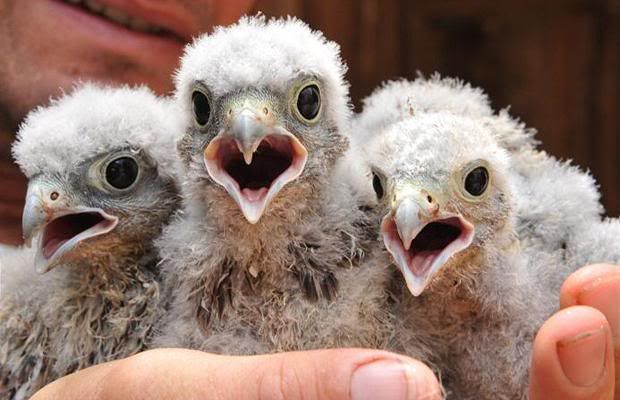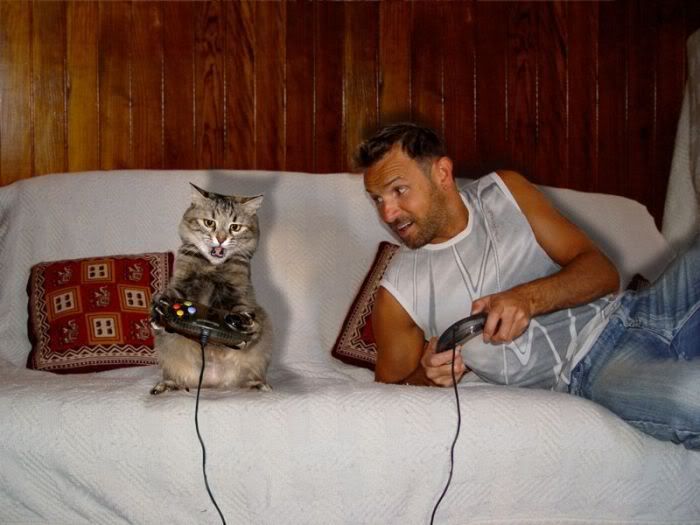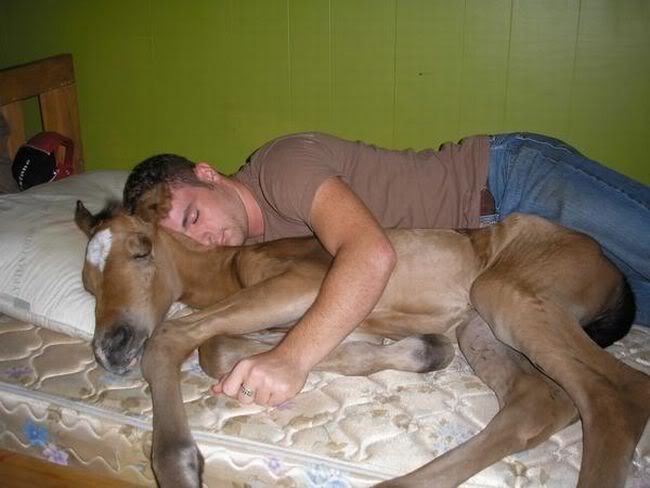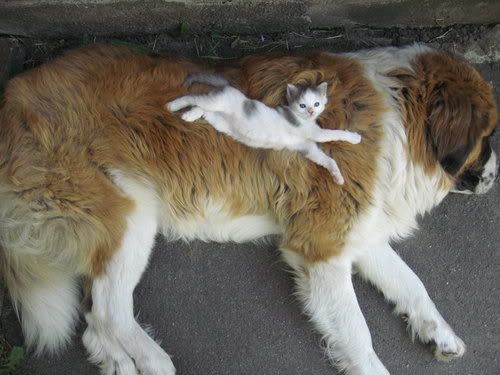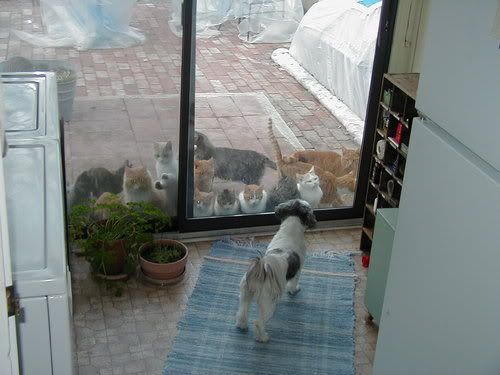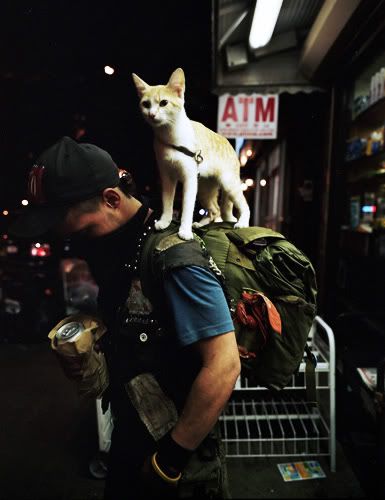 You may be surprised to find out that not all hospice patients live in homes with family members around to care for them. Some of our patients are single, whether they are unmarried, divorced or widowed. Some are childless, estranged from immediate or distant family or have relatives who live out of state. These patients want to stay at home during their time on hospice, rather than being forced to move to an unfamiliar location to spend the end of their lives. In these instances, pets may be all the family they have. Here at Hospice of Green Country, we respect our patients' right to live and die in their own homes and we have special programs in place to make that is possible, to keep them safe and cared for at home. Pet Peace of Mind makes sure that their pets are kept well fed, healthy and comfortable as well, providing food, medications, flea and tick preventative and grooming. Petsitting services are also available if the patient becomes unable to care for their pet because of their declining condition. In the same way that we believe a patient has the right to die at home, we believe that they have the right to have their dog or cat by their side for support and comfort. We don't want our patients to spend the end of their lives grieving the loss of a beloved pet.
You may be surprised to find out that not all hospice patients live in homes with family members around to care for them. Some of our patients are single, whether they are unmarried, divorced or widowed. Some are childless, estranged from immediate or distant family or have relatives who live out of state. These patients want to stay at home during their time on hospice, rather than being forced to move to an unfamiliar location to spend the end of their lives. In these instances, pets may be all the family they have. Here at Hospice of Green Country, we respect our patients' right to live and die in their own homes and we have special programs in place to make that is possible, to keep them safe and cared for at home. Pet Peace of Mind makes sure that their pets are kept well fed, healthy and comfortable as well, providing food, medications, flea and tick preventative and grooming. Petsitting services are also available if the patient becomes unable to care for their pet because of their declining condition. In the same way that we believe a patient has the right to die at home, we believe that they have the right to have their dog or cat by their side for support and comfort. We don't want our patients to spend the end of their lives grieving the loss of a beloved pet.
Pets and Single Patients
 You may be surprised to find out that not all hospice patients live in homes with family members around to care for them. Some of our patients are single, whether they are unmarried, divorced or widowed. Some are childless, estranged from immediate or distant family or have relatives who live out of state. These patients want to stay at home during their time on hospice, rather than being forced to move to an unfamiliar location to spend the end of their lives. In these instances, pets may be all the family they have. Here at Hospice of Green Country, we respect our patients' right to live and die in their own homes and we have special programs in place to make that is possible, to keep them safe and cared for at home. Pet Peace of Mind makes sure that their pets are kept well fed, healthy and comfortable as well, providing food, medications, flea and tick preventative and grooming. Petsitting services are also available if the patient becomes unable to care for their pet because of their declining condition. In the same way that we believe a patient has the right to die at home, we believe that they have the right to have their dog or cat by their side for support and comfort. We don't want our patients to spend the end of their lives grieving the loss of a beloved pet.
You may be surprised to find out that not all hospice patients live in homes with family members around to care for them. Some of our patients are single, whether they are unmarried, divorced or widowed. Some are childless, estranged from immediate or distant family or have relatives who live out of state. These patients want to stay at home during their time on hospice, rather than being forced to move to an unfamiliar location to spend the end of their lives. In these instances, pets may be all the family they have. Here at Hospice of Green Country, we respect our patients' right to live and die in their own homes and we have special programs in place to make that is possible, to keep them safe and cared for at home. Pet Peace of Mind makes sure that their pets are kept well fed, healthy and comfortable as well, providing food, medications, flea and tick preventative and grooming. Petsitting services are also available if the patient becomes unable to care for their pet because of their declining condition. In the same way that we believe a patient has the right to die at home, we believe that they have the right to have their dog or cat by their side for support and comfort. We don't want our patients to spend the end of their lives grieving the loss of a beloved pet.
Natural Flea Control for Dogs and Cats

By Linda Cole
They're baaaack! Fleas are once again climbing from their hiding cracks and crevasses and mounting an invading army with your pet as the target. Many pet owners wrestle with the same question every summer. Do I stick with the usual control that uses chemicals to kill the fleas, or is it time to try a natural control?
For animals who have had allergic reactions or other medical and sometimes life threatening reactions to over-the-counter flea control, the answer is simple. More and more owners are taking a look at natural flea control to avoid harsh chemicals found in many of the topical medications that are on the market. However, when it comes to battling an obnoxious pest that can also do bodily harm to your pet, some kind of flea control is essential. If you’re looking for alternative solutions, the news is good – with natural ways to combat the mighty flea.
As with any flea control, you have to be consistent and dedicated to stay ahead of flea infestations. Most natural control can take up to a month before you start to see results. Don't be discouraged. Find what works best for you and your pet, and implement several of the natural flea control solutions.
Apple Cider Vinegar makes the skin taste acidic to fleas, so don't substitute any other vinegar. Depending on the size of your water bowl, add one tablespoon per cup of water. Don't stop if your pet gives you “that look.” Animals adapt. If they refuse to drink the water, you can mix a 50/50 solution in a spray bottle and put it directly on your pet.
Brewers Yeast with Garlic is a favorite of mine because it can be used as a treat or put directly on their food. Not all pets like it, but those who do will wolf it down. Brewers yeast can be purchased in tablets or powder. It contains B vitamins, biotin, proteins and zinc, and can help improve your pet's blood, skin and immune system. Like apple cider vinegar, it works from the inside by giving the pet's skin an odor and taste not appreciated by fleas. If your pet won't eat brewers yeast, mix up 1/4 cup powered yeast in a quart of water and pour into a squirt bottle. Spray on your pet and work the yeast and water into their coat as you spray. You can also use powered yeast as a flea powder. Shake it over their coat, working it in as you dust.
Rosemary: To make a dip with rosemary, use two cups fresh herb to one gallon of warm water. If your dog is super-sized, you will have to adjust the amount for size. Steep the rosemary for 30 minutes in boiling water. Pour into a gallon of warm water and allow it to cool slightly. You want your mix to be warm, not hot. Pour over your pet and let them air dry for best results.
Lavender Essential Oil has been used in the past to treat anxiety in cats; however, I don't recommend this for cats as a natural flea control because it can build up and become toxic to them. For your dog, simply place a couple of drops at the base of their tail and the back of their neck after bathing them.
Lemon: Take two or three lemons and slice them rind and all. Drop into a quart of boiling water and let it set overnight. Strain out any pulp before using. Use this solution to sponge over your pet or put in a spray bottle. Let them air dry. Lemon can also help condition your pet's skin as well as repel fleas.
Raw Garlic should be used with care, as some animals tolerate it better than others. Never give raw garlic to your cat or dog unless you have checked with your vet first. Too much can make your cat anemic, and the jury is still out for dogs. Talk with your vet for specific dosage and any health concerns you need to be aware of before starting your pet on garlic. Fleas are nasty critters for your pet, but too much raw garlic can be equally damaging for your pet.
Keep in mind that natural flea control does not kill fleas or their eggs, it only repels them. When using any natural control, administer outside where the fleas can vacate your pet away from the cracks and crevices of your home.
As with any flea control, your pet's environment also needs to be kept clean. A thorough daily vacuuming will help keep fleas in check as well as remove any eggs. Make sure to vacuum the furniture too, and wash your pet's bedding regularly.
Read more articles by Linda Cole
Labels:
canidae,
dogs,
fleas,
Linda Cole,
natural flea control,
pests,
pets
Poll Finds Pets Are People Too!
A new poll by AP-Petside.com investigates how much pet owners treat animals as human beings. Findings reveal that half (50%) of all American pet owners say their animals are just as much a part of the family as any person in the household.
Another interesting bit of data - 43% of pet owners think their pooch or kitty has their own sense of style, with 1 in 5 dressing them up in fashionable attire. Other topics include where pets sleep, whether owners feed human food to their pets,celebrating pets birthday, top pet names, and whether or not pets are featured in family photos and holiday greetings.
Here's the link to the story
The only thing I found surprising is that there weren't more people who said they treated their pets like part of the family.
Another interesting bit of data - 43% of pet owners think their pooch or kitty has their own sense of style, with 1 in 5 dressing them up in fashionable attire. Other topics include where pets sleep, whether owners feed human food to their pets,celebrating pets birthday, top pet names, and whether or not pets are featured in family photos and holiday greetings.
Here's the link to the story
The only thing I found surprising is that there weren't more people who said they treated their pets like part of the family.
Labels:
Pet Industry
Should I Relax, or be Productive?

"What did you accomplish this weekend?"
I hear that question almost as much as I ask it. Did I have a productive weekend, I wonder? And why is it I feel that I have to have accomplished a great deal not only during the week, but also on Saturday and Sunday? Whatever happened to a relaxing weekend, or even keeping the Sunday as a day of rest?
I'm not a workaholic, perfectionist or Type A personality. But I also don't enjoy puttering or sitting around and I hate having the television on during the day. Like many people, I guess I don't really know how to relax. Does a vacation sound relaxing? I know few people who come home from a vacation feeling anything but absolutely exhausted (and facing piles of laundry to do.) When I go home to visit family in Vermont, I am so short of time I try to pack everything in and visit everyone, and end up having little quality time with anyone. The only real vacation I took was to Disneyworld, where we woke up early every morning, followed an itinerary to make sure we experienced the most desired shows and rides, and stayed out until well after midnight, walking from parks to bus stops to hotels until our feet ached. I'm sure there are some vacationers out there who know how to sit on the beach, bask in the sun, enjoy leisurely dinners and come home refreshed, but I've never met one.
So, just like vacation time, I've never considered having a purely leisurely weekend. This past weekend I cleaned the fridge, went to a high school graduation, shopped for my church's 200th Birthday Party celebration, not to mention regular tasks such as cooking meals and walking the dog. Sunday I went to church, worked outside, weeded the garden, organized a closet, critiqued some stories, and called Mom.
I wonder if I can re-train my thinking. Can I ever feel good about abandoning the To-Do list and putting my feet up, visiting with an old friend, swaying on the garden swing with my husband, spitting watermelon seeds with my son, throwing a stick to my dog?
Maybe, in a way of thinking, that's productive.
What I Learned from My Dog: Appreciate every moment of every day. Kelly runs down the stairs, ears flopping, tail wagging. She picks up a toy joyfully. She doesn't do anything really important. But she is there in each moment, living it.
Labels:
appreciate,
dog,
productive,
To-Do list
10 Most Diabolical Fish On Earth
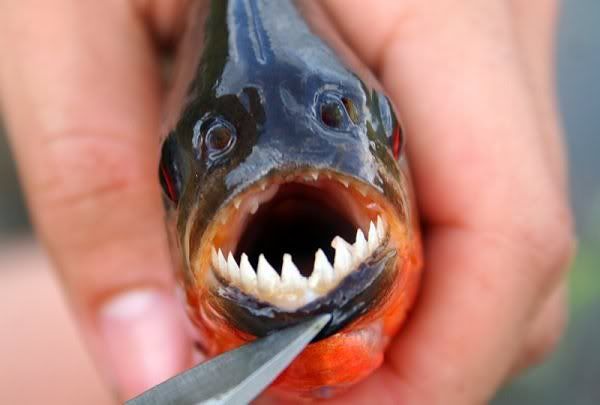 This piranha is one of the disgusting looking creatures included in Environmental Graffiti's list of the 10 Most Diabolical Fish On Earth.
This piranha is one of the disgusting looking creatures included in Environmental Graffiti's list of the 10 Most Diabolical Fish On Earth.Don't go in the water!
Photo from Flickr, by Laura Travels
Litter Box Training Do’s and Don’ts

By Julia Williams
Cats are fastidious and intelligent creatures that instinctively cover their waste, which makes litter box training a kitten so much easier than house training a puppy. Score one for kitties in the “cats versus dogs” debate!
If you adopt a new kitten that was raised indoors with its Mama, it will most likely already be trained to use the litter box. However, if you are fostering young kittens for a shelter, raising a litter of kittens, or adopting one that isn’t using a cat box yet for some reason, you will need to do some training.
If you’re lucky, your litter box training might involve little more than placing the kitten in the box a few times. As I said, cats are smart (okay, maybe I am biased just a little) and they generally use their litter box right away. Nonetheless, there are some Do’s and Don’ts to keep in mind. Establishing good litter box habits at an early age is the key to avoiding problems in the future.
Litter Box Do’s
* Choose an appropriate box. My friend adopted a kitten recently, and I went with her to pick it up. When we arrived at her house with kitten in hand, she showed me the litter box she’d bought. It was a splendid covered cat box with a flap door, just like the one I use for my cats. Unfortunately, the entrance is a good 8” from the floor – which is fine for an adult cat but definitely not a tiny six-week-old kitten! We both had a good laugh, and then we went out to get a kitten-sized litter box with low sides that her new little fur-baby could easily climb over.
* Choose the right cat litter. Kittens often taste their litter, and there is concern among some cat lovers that the clumping clay litter can harm their digestive systems. I don’t know anyone who’s experienced that, but if you want to err on the side of caution, there are several natural alternatives you can try. My favorite natural cat litter is made from finely ground corn; others include wheat, sawdust and pine pellets.
*Location, location, location. As in real estate, the location of your cat’s litter box is very important. It should be placed in an easily accessible area that’s relatively quiet and offers some privacy. Make sure the cat box is not located near appliances that make startling or loud noises, such as washing machines or refrigerators. If you have toddlers or dogs, put the litter box in an area that you can make off limits to them with a baby gate. This is to make sure kitty doesn’t get ambushed while doing his business, and also to keep curious hands and mouths out of the cat litter.
* Provide more than one litter box if you have several cats, or have multiple stories in your home that the kitten will have access to.
* Confine a young kitten to a small area until you know they are consistently using the litter box, particularly at night while you’re asleep.
* Take your kitten to the litter box throughout the day, particularly if you see it sniffing around as though looking for a spot to “go.” The first few times, you can very gently scratch the litter with the kitten’s paws to simulate the digging, although it’s not really necessary. When your kitten uses the litter box, it’s a good idea to praise and pet them, to let them know they did a good thing and you’re happy with them.
Litter Box Don’ts
* Accidents may happen. Never, ever punish your kitten by spanking or rubbing his nose in the mess. This only creates fear, distrust, and a cat that will grow up not wanting to be in your company. Be sure to clean the area they soiled with a product containing enzymes which remove the scent.
* Don’t change the type of litter if your kitten seems to like the one you have. If you do decide to try a new cat litter, mix it into the old litter gradually if the type of litter is compatible. For instance, when I switched from clumping clay to corn-based litter which is also a clumping type, I added a little of the new along with the old for several weeks.
* Don’t forget to clean the box regularly. For some cats, that may mean daily scooping.
* Don’t move the litter box to a new location suddenly. If you want to change the location, leave the old box where it is and place a second box in the new spot until your kitten is using it regularly.
* Don’t tempt fate by leaving a large potted plant at floor level. The dirt is attractive to kittens, and they might use it as a toilet or just have some fun digging in it.
Your litter box training should be a breeze if you remember three simple things: start early, stay consistent and provide a suitable environment for your “feline loo.”
Read more articles by Julia Williams
Labels:
canidae,
cat,
cat litter,
Julia Williams,
litter box training
How to Give Your Dog a Bath

By Anna Lee
Humans need to bathe to remove grime, dirt and dust from our skin. Dogs need to be bathed to remove the dirt and grime from their coats. Dogs do have a natural “doggie smell” which a bath will help improve. It is part of a regimen that is important for the health of your dog. Bath time is also an opportunity for you to check for anything unusual on your dog’s body such as a lump, a scratch, or a tick, as well as a great bonding experience.
A dog does not need a bath as often as a human does. It is not recommended that you give your dog a bath more than once a week. You will judge when your dog is in need of one. I know when my dog needs a bath as she gets that “doggie” odor!
Supplies You Will Need
Dog shampoo is formulated for dogs and is the only shampoo you should use. Do not use the shampoo you use for your hair, or baby shampoo, or your bath soap. These products will dry out your dog’s coat. There are a variety of specialized dog shampoos such as whitening shampoo to be used on white dogs to eliminate the touch of yellow they sometimes get. There is odor control shampoo which is good for dogs that spend a lot of time outside, dog shampoo for sensitive or dry skin, and medicated shampoo. Choose the one that is right for your particular dog’s needs.
Towels are a must! I purchased a micro bath towel for my dog, which absorbs a lot of water. It’s important to get your dog as dry as possible. If you don’t have a micro towel, a large towel of any type will work. Old beach towels make excellent dog towels.
If you trim your dog’s nails yourself, have the nail timer handy too. You might as well use the dog toothbrush and toothpaste as the final part of the job. Finish up by rewarding your dog with a CANIDAE® dog treat or two.
The Bath Process
In order to keep your dog relaxed, continually talk to your dog during the bath. Your voice will be a calming influence and it will take his mind off of what you are doing if he isn’t one who enjoys a bath. The best way to shampoo a large dog would be outside with the garden hose. First you should thoroughly wet the dog’s coat. Apply a liberal amount of shampoo to the dog and rub it in. Use your hands to make sure you get all the nooks and crannies. While doing that, it’s the perfect opportunity for you to check for lumps, scratches or anything out of the ordinary. Once well lathered, give the dog a thorough rinse. It is not necessary to lather the dog twice unless there had been a run in with a skunk! If you have a small dog and have a utility sink, that would be the perfect spot for a bath.
Ears and Nails
Once the dog is almost dry, this is a good time to check the ears for wax. Labs are prone to wax building up because they have very close set ears which does not allow for good air flow. Since you have the dog’s attention it is a good opportunity to check the nails. If you brush your dog’s teeth this is a good opportunity to take care of that.
Rewards
By this point the dog is most likely getting a little bored with the bath game, and you are probably ready to put on dry shoes. Now it’s reward time! Take a few minutes to praise the dog for enduring the bath, throw his favorite toy or ball for him a few times and give him a dog biscuit as a reward. He will learn to associate bath time as a good thing.
A bath is necessary for the overall good health of your four legged pooch. If you follow the simple process outlined above, your dog will look good and smell nice – and be healthier, too. If, after all of this, you find it impossible to bathe your dog yourself, then go ahead and take him for a professional grooming. Check with your vet for a recommendation. The vet I use also has a groomer on staff for a reasonable price.
Read more articles by Anna Lee
Labels:
Anna Lee,
canidae,
dog shampoo,
dog toothbrush,
dog treat
Do you own a bored bunny?
 Give your rabbits hours of fun.
Give your rabbits hours of fun.This bunny playground is sold by the Bunny Bunch SPCR (Society for the Prevention of Cruelty to Rabbits), so your money goes to helping rabbits.
For $289.00 at Bunny Bunch Boutique
(via Rabbit Merriment)
Labels:
animals,
merchandise,
pets,
rabbits
Win A 5-Star Accommodation For Your Pet
More than half of all pets are left behind when their families travel. PetSmart® (NASDAQ: PETM) knows pet parents want only the best care possible for their loved ones while away, so PetSmart PetsHotel® associates go to great lengths to give pet guests the personal TLC to make them feel right at home.
PetSmart has given me an overnight stay, doggie day camp, and a treat time voucher - a $60 value - for free to one lucky reader.
All you have to do to enter is leave a comment with your favorite vacation spot, and we'll use a random number generator to choose a winner. Contest is open through July 5th!
Here is some more information on PetSmart Hotels
No Request too Great
Take Coco Lamb, a 140-lb. Irish Wolfhound in Joliet, Ill., who only eats his dinner from a spoon. Coco's family drives more than 30 miles to their nearest PetsHotel in for this VIP treatment.
Rising to these unique requests is just part of what makes a pet's stay at the PetSmart PetsHotel so special. Whether it's the spoon-fed care of an affectionate associate or an associate rocking a dog named Mitzi to sleep to her parent's lullaby over the Bone Booth™ telephone, these are just a few examples of care provided at the PetsHotel.
Check out these links!
Over Night StayDoggie Day Camp
Dog Services
Please note that PetSmart hotel is not affiliated with The Pet Haven Blog and this blog assumes no responsibility for the items given away other then offering the promotion on their behalf.
All dogs and cats are welcome at the PetsHotel, provided they have necessary vaccinations, including rabies and bordetella every six months. Average rates for dogs staying at the PetsHotel range from $23 to $37 per night depending on room type. Activities including Doggie Day Camp range from $20 to $25, and varies by location. Cats stay for $14 per night. A la carte services and upgrades range from $3 to $16.
PetSmart has given me an overnight stay, doggie day camp, and a treat time voucher - a $60 value - for free to one lucky reader.
All you have to do to enter is leave a comment with your favorite vacation spot, and we'll use a random number generator to choose a winner. Contest is open through July 5th!
Here is some more information on PetSmart Hotels
No Request too Great
Take Coco Lamb, a 140-lb. Irish Wolfhound in Joliet, Ill., who only eats his dinner from a spoon. Coco's family drives more than 30 miles to their nearest PetsHotel in for this VIP treatment.
Rising to these unique requests is just part of what makes a pet's stay at the PetSmart PetsHotel so special. Whether it's the spoon-fed care of an affectionate associate or an associate rocking a dog named Mitzi to sleep to her parent's lullaby over the Bone Booth™ telephone, these are just a few examples of care provided at the PetsHotel.
Check out these links!
Over Night StayDoggie Day Camp
Dog Services
Please note that PetSmart hotel is not affiliated with The Pet Haven Blog and this blog assumes no responsibility for the items given away other then offering the promotion on their behalf.
All dogs and cats are welcome at the PetsHotel, provided they have necessary vaccinations, including rabies and bordetella every six months. Average rates for dogs staying at the PetsHotel range from $23 to $37 per night depending on room type. Activities including Doggie Day Camp range from $20 to $25, and varies by location. Cats stay for $14 per night. A la carte services and upgrades range from $3 to $16.
Labels:
Contests,
Pet Industry
What Does “Responsible Pet Ownership” Really Mean?

By Ruthie Bently
From time to time, CANIDAE puts “freebies” in their bags of food. The first bag of their food I bought had a magnetic calendar in it; the next bag I got had a bracelet in it. On one side it says “CANIDAE® All Natural Pet Foods” and on the other side it says “RESPONSIBLE PET OWNERSHIP.” I don’t need to be reminded what that means, however I wear it every day so it is always in my focus. But what does responsible pet ownership really mean?
It means doing everything you can to make sure that the pet you choose (or the pet that chooses you) has the best life you can provide for them. If you pick a puppy, it means regular vet visits for the first year with booster shots, having your puppy neutered or spayed if you're not a breeder, teething and everything else that owning a puppy entails. It means getting into a puppy class for training and socialization so you have a well-behaved dog. High quality food and fresh water daily are on the list too, and should be at the top. You need to provide proper teething and chewing toys for your pet, as well as toys for regular exercise. You may even want to consider giving your dog a job to do, as they thrive on variety in their lives.
Responsible Pet Ownership means dealing with ticks, fleas, heartworms, kennel cough and all the other parasites and diseases that may come along. It means regular grooming, bathing and toenail clipping. It could also include picking burrs and weed seeds out of paw pads and coats, so they do not imbed themselves and cause an infection or a matt in the fur. Responsible Pet Ownership means having a safe place for your pet to play outside, with proper shade and confinement, as well as fresh water.
If you adopt a “special needs” pet, it could mean dealing with daily medications, healing salves, physical rehabilitation, monthly vet visits, even sizing changes for a cart if that is what your dog needs to move around. Responsible Pet Ownership means being vigilant every hour of every day to keep your pet safe from environmental dangers that may be in your home and on your property that you may not even realize exist.
It means living with a sentient creature that loves you just because you are. They don’t care how long you spend away from home and dance around when you get back. They don’t care if you have had a bad day at work, they are just glad you are home. They snuggle with you when you are sick, and cuddle with you on cold winter nights. They will hog the blankets and the bed (if you let them). They get you to exercise and spend more time outside in the sun, the rain, the snow and everything in between. They give unconditional love, are non-judgmental and expect nothing in return. They make us better humans, because they can.
It doesn’t really matter what kind of an animal you choose to spend your life with. Just like us, they have quirks or oddities; whichever word you choose will suffice. That’s not important to them, as they just want to be with us. As a species, we are truly blessed if we have an animal or two (or more) in our lives. They make us better humans.
Read more articles by Ruthie Bently
Labels:
canidae,
cat,
dog,
responsible pet ownership,
ruthie bently
A horse is a horse, of course, of course
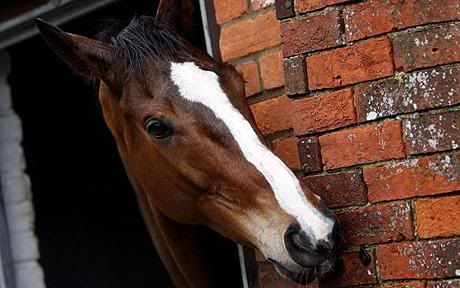 In an effort to stop vets' drugs from entering human diets, the nations of continental Europe, where two million horses are reportedly eaten every year, will be enforcing a new law requiring horse owners to sign a pledge that their horses will not be eaten.
In an effort to stop vets' drugs from entering human diets, the nations of continental Europe, where two million horses are reportedly eaten every year, will be enforcing a new law requiring horse owners to sign a pledge that their horses will not be eaten.The new regulations come into force on July 1. Horses born after this date, and those born before June 30 who have not been issued a horse passport, will also have a microchip implanted.
A spokesman for the Department for the Environment Food and Rural Affairs said: "Horse passports will clearly identify those horses which are not eligible for the food chain if they have been treated with substances which are potentially harmful to humans.
Source
Photo: PA
Understanding Dog Pack Hierarchy, and Why it Matters

By Linda Cole
Dogs are social animals with a well defined pack hierarchy. Like the wolf pack, each individual in the pack has its own place in that social order. Without a leader and parameters, a dog pack is confused, unstable and in constant conflict. Whether you are a pack of one dog or multiple canines, it's important to understand the structure of the pack in order to maintain your role as leader.
As pack leader, it's up to you to set rules and limitations for your dog. They are looking to their human alpha leader for consistent guidance and behavior you deem appropriate. A stable relationship is created when your dog understands what you expect from them.
A wolf pack hierarchy is made up of one alpha male and an alpha female. Next in line is the beta, and the omega is the lowest member of the pack. The other pack members fall in between the alpha and omega. The alpha male is the only one who leads and makes all the decisions that the entire pack follows, such as when and where to hunt, and when the rest of the pack can eat. He takes the best sleeping spots and is the only one allowed to mate with the alpha female. Any individual member who fails to obey the rules will be dealt with in a swift and appropriate manner. Those who refuse to follow pack laws are sometimes driven out in order to maintain stability.
Our dogs operate under the same hierarchy. They are born with an instinctive sense of pack mentality. Observe any litter of pups as they grow and mature. Dominate and submissive personalities begin to show as they play and interact with their litter mates. Mom keeps them in line with little nudges and nips around their neck and ears. These gentle reminders and punishments learned as pups will remain with them throughout their lives.
To establish yourself as top dog in the pack hierarchy, you have to first know which animal in your pack is the alpha. A female can be recognized by the pack as their alpha leader. Observe your dogs to see which one shows dominate behavior over the other dogs or yourself. Dominate behavior will include bumping, blocking, moving in between you and other dogs, standing alert with their tail held high (a sign of confidence), low growling whenever another dog comes near or making eye contact and holding it. Control the alpha, and you control the rest of the pack.
Never yell, hit, kick or spank any dog. It is not something they understand and will only create a more aggressive or fearful dog in the long run. You will certainly not gain any respect or trust. Respect can't be forced; you have to earn it by controlling your pack on their terms. You become the alpha by making all the decisions for the pack. You eat first, go through a doorway first, determine which dog gets attention and when it's given, win the tug of war game, sit and sleep in the prime spots, “move” a pack member out of your way instead of walking around or stepping over them. In other words, you establish yourself in the pack hierarchy as the alpha by controlling their basic needs and desires.
Dogs want to please us and be our protectors and companions. We create and allow unwanted behavior each time a member of our pack is allowed to misbehave with no consequences from the boss. A true alpha leader in the social order of the pack hierarchy would never allow misdeeds to go unpunished. This causes confusion and a breakdown in their social order which in turn creates an unstable pack.
The best way to show our pets just how much they mean to us is to treat them as rightful members in the pack hierarchy. Each one knows their place in the pack and you, as their alpha leader, have set the parameters and rules they will abide by. Stay calm, cool and assertive when you need to remind a rule breaker who the top dog is by administering appropriate and fair discipline. By learning how to lead, you are creating stable dogs who know their place and obey the wishes of the one who controls the pack.
Read more articles by Linda Cole
Labels:
alpha dog,
canidae,
dog packs,
Linda Cole,
pack hierarchy,
pack leader,
wolf packs
DIY Bird Mobile
 Tutus and Turtles says this bird mobile would really brighten up a corner of a child's room. Read more about the how-to here and here, and get the bird pattern here.
Tutus and Turtles says this bird mobile would really brighten up a corner of a child's room. Read more about the how-to here and here, and get the bird pattern here.(via [bb-blog])
How to Transport Dogs Safely in Pickup Trucks

By Julia Williams
The other day I was traveling on the freeway when I noticed the pickup truck in front of me had a beautiful chocolate lab bouncing from one side of the truck bed to the other. I was appalled to see that the dog was not tethered in the back of the truck! I’ll never forget the terrified look on the dog’s face as he struggled to maintain his balance and keep from flying out of the truck.
Transporting your dog untethered in the open bed of a pickup truck is an accident waiting to happen. When you let your dog ride loose in the back of your pickup, you endanger both your dog and other motorists. One quick turn, abrupt stop or unexpected bump in the road, and your dog can be catapulted into traffic. This can result in painful broken bones, bruises and road rash, and even death. If they do manage to survive the fall and oncoming traffic, it can cost thousands of dollars in veterinary bills to fix them up.
Letting your dog ride unsecured in the back of a pickup truck is not only unsafe and potentially deadly for dogs, it’s illegal in some states. Most states that don’t yet have legislation in place to protect dogs from this dangerous practice, are working on it. Regardless of the law, responsible pet owners have a moral duty to ensure the health and safety of their companion animals, both at home and on the road.
Some people believe that taking the dog with them is better than leaving them home alone. But consider this: having a lonely dog waiting for you when you get home is a million times better than having one get killed or injured from falling out of a pickup truck bed.
If you simply must take your dog with you in the back of your pickup truck, there are several different options for keeping your beloved canine companion safe. The safest is to buy a topper for the truck bed so your dog can ride in an enclosed area, protected from the road and wind hazards.
A large, sturdy dog crate (such as those required for airline transportation) is also a good option, provided that the crate is securely tied down to prevent it from sliding around the truck bed floor. Although these cost less than a truck bed topper, they can still run several hundred dollars or more depending on the size and type of crate you buy.
Another option is to secure the dog directly behind the truck’s cab by cross tethering. This is accomplished by securing a rope to each side of the truck, with a short leash attached in the middle for the dog. Be aware, however, that if the leash is too long, the dog could fall from the truck's rear and be dragged along the street.
Cross tethers designed specifically for restraining dogs in the backs of pickups can be found at most pet stores as well as online. A properly installed cross tether secures the animal to the truck in such a way that it can't go over the bed or choke itself. The safest (and most comfortable) way to cross tether your dog is with the addition of a padded harness. This prevents entanglement and limits the dog’s range of motion to ensure that he won’t choke.
The German Shepherd in the photo above is using the Kurgo K9 Truck Tether along with the Kurgo Smart Harness which is made from automotive seatbelt webbing. This tether and harness will fit all pickup trucks, and can also be fitted to the vehicle's seats to allow your dog to ride inside during inclement weather. Both of these together cost less than $50. That’s such a small price to pay to keep “man’s best friend” safe and sound while riding in the back of a pickup truck.
Read more articles by Julia Williams
Labels:
best friend,
canidae,
cross tether,
dogs,
Julia Williams,
pickup truck
You can catch MRSA from animals
 An infectious superbug, a strain of bacteria known as MRSA, which has evolved a resistance to antibiotics, has long plagued hospitals but in recent years has become more common in homes. About two years ago, scientists began to suspect that pets can spread this bacteria.
An infectious superbug, a strain of bacteria known as MRSA, which has evolved a resistance to antibiotics, has long plagued hospitals but in recent years has become more common in homes. About two years ago, scientists began to suspect that pets can spread this bacteria.In the July edition of The Lancet Infectious Diseases, Richard Oehler of the University of South Florida College of Medicine and colleagues lay out the latest thinking on MRSA (methicillin-resistant Staphylococcus aureus) and pets.
The infections can be transmitted by animal bites and most threaten young children, the researchers note. "MRSA colonization has been documented in companion animals such as horses, dogs, and cats, and these animals have been viewed as potential reservoirs of infection."
"Bites to the hands, forearms, neck, and head have the potential for the highest morbidity," the scientists warn. They conclude: "Much more remains to be learned about MRSA and pet-associated human infections."
Source
Photo from Flickr, by GrahamIX
Dealing with the Diagnosis of Hip Dysplasia

By Anna Lee
Hip dysplasia is a common problem among large breed dogs; however, the diagnosis is no longer something to fear or shy away from. With the proper medication, weight control and exercise your dog can lead a normal and fun-filled life. I know because I have an 11-1/2 year old yellow lab that swims, runs, and enjoys life while living with hip dysplasia.
Hip dysplasia is a genetic disease that affects a dog’s hip joints. Obese dogs are more prone to hip dysplasia. Pet owners need to make sure they feed their dogs a high-quality food and treats to ensure proper nutrition and weight. It is common to find hip dysplasia in large dogs such as Chesapeake Bay Retrievers and Labrador Retrievers.
The hip joints, known as ball and socket joints, are what attach the dog’s hind legs to its body. Those joints need to rotate freely in order for the dog to walk normally. A dog’s hip joints are similar to those in humans. The most common way hip dysplasia is diagnosed is when the dog has a noticeable limp and is taken to the vet.
My lab, Abby, was diagnosed quite accidentally with severe hip dysplasia in 2001, when she was just shy of two years old. She had winced in pain while running through the woods. She hit the ground and stayed there for a while. When she stood up we knew she was in pain, as she was limping and whimpering. We took her to the vet, who told us she had ruptured the cruciate ligament in the left knee, which is a common knee injury. She was overweight by about 20 pounds at that time. The vet said to schedule surgery in a week and told us to put her on a diet. He wanted her to lose weight to help take some pressure off of her knee and help in her recovery.
We put her on a diet and a week later took her in for surgery. The vet told us they would take x-rays, operate on the knee and call us when she was in recovery. The doctor called me within an hour to tell me that the x-ray showed she also had extreme hip dysplasia in both hips and would probably not live to be 5 years old. This was not at all what I had expected to hear. Needless to say I was at my wits end. I don’t know how I got through until the next day when we picked her up.
Her recuperation from the knee surgery was excellent. I was told she would not put weight on the knee for a week. He didn’t know Abby very well, as she put weight on it two days later and was walking with just a slight limp after a few weeks. We also learned when a dog blows out one knee the second knee will follow suit.
A few months after the knee surgery we moved 700 miles to Tennessee. Three months later she blew out the other knee. We took her to a vet who was recommended as an expert in knee injuries. At least by then she had lost over 20 pounds and was in much better condition. I told the new vet about her previous knee surgery and also about the hip dysplasia. He said he would take x-rays and review her hips.
When we picked her up after surgery the vet said she did very well. We could see that, as she was walking out with him using all four legs! His procedure was much different from the first vet. Her scar is half the size and she was able to walk without a limp within a week. He also gave us the good news that her hips were not as bad as we had been told and we should just take it day by day.
Five years later she when she was about 7, the hip dysplasia started to rear its ugly head. She refused to get in the back of our SUV, which was the first clue. We took immediate action and drove her directly to the vet. We were living in a different area of Tennessee, therefore, a different vet yet again. This time we had a female vet and she said x-rays were needed but she was sure it was the hips giving her problems. We left her there for the x-rays, and when we picked her up later that day the vet showed us the film. We could clearly see how different her hip joints looked compared to what a normal joint looks like.
I was prepared for the worst, but the good news was that she did not need hip surgery. We discussed two medications and chose the one that fit her needs better. She gets 50 mgs once a day in a chewable tablet. Does she still have problems? Yes, and she always will. Her big problem areas are steep steps, sitting down and getting up. She walks fine and she runs like the wind. She can run around the pool at full speed, jump in for her Frisbee, swim to the steps and climb out. She can do that for hours on end. Without her meds she would not be able to be that active without a noticeable limp.
In 2001 we were told she would not be with us longer than 5 more years. Well, it’s 8 plus years later and she is living proof that with the right vet and the right medications, hip dysplasia is not the end of the world. The bottom line is this: get a second opinion or a third if necessary. Do your own research and then find a vet you can trust with your dog’s life. Don’t panic when you hear the diagnosis of hip dysplasia. With love, proper nutrition and medication, your dog can live a long and active life!
Read more articles by Anna Lee
Labels:
Anna Lee,
canidae,
dog food,
hip dysplasia,
large breed dogs,
nutrition
Will you take your dog to work on Friday?
 On June 26 a few thousand companies will participate in Take Your Dog to Work Day, which was created by Pet Sitters International 10 years ago.
On June 26 a few thousand companies will participate in Take Your Dog to Work Day, which was created by Pet Sitters International 10 years ago.The event lets companies across the country celebrate dogs and promote adoption of pets from animal shelters and breed rescue clubs.
Last year, more than 1,000 companies registered, but the American Pet Products Association found that 1 in 5 businesses are currently pet-friendly.
So, which businesses are the most pet-friendly? Petside.com ranks the top 5 pooch welcoming employers:
1. Printing For Less
2. Procter & Gamble's Pet Care division
3. Wonderware, Inc.
4. Diversified Technical Solutions
5. Replacements, Ltd.
Photo from Flickr, by -[Matt]-
Labels:
animals,
dogs,
pets,
take your dog to work day
Pet Summer Safety
The weather is getting warmer, and hopefully here on the east coast, the rain will stop. Here are some good tips to help your furry friends enjoy the summer.
Transportation
Never leave your pet in an unattended car. On warm days, the temperature in your car can rise to 120 degrees in a matter of minutes, even with the windows slightly open.
When you bring your pet along on a car ride, use a pet safety harness. If an accident were to occur, a pet safety harness can ensure that every passenger is protected.
If your dog must ride in the back of a pick-up truck, make sure that he or she is in a crate that is secured to the bed of the truck. If you were to suddenly hit the brakes, swerve or be hit by a car, it could result in serious injury not only to your pet, but to other drivers.
Do not travel with your pet on an airplane unless it's absolutely necessary. If you plan on bringing your pet on vacation, consider driving to your destination. Otherwise, think about leaving your pet behind under the care of a pet sitter or boarding kennel.
Wellness
Only use veterinarian-approved flea and tick control products. Over-the-counter products may contain ingredients that have been found to harm pets. For more information about what chemicals to avoid, click here.
Make sure that your pet is protected from heartworm. Dogs and cats are at higher risk of contracting heartworm during the summer because there is an increase of mosquitoes, which transfer the disease. Contact your veterinarian in order to determine the best schedule for heartworm testing and preventive medication for your pet.
Protect your pet from the heat by providing him/her with large amounts of fresh water and keeping them indoors with you and providing plenty of shade when they are spending time outdoors.
On hot days, limit your pet's exercise to the early morning or evening hours. Also, keep in mind that the hot asphalt can burn your pet's paws.
Precautions
Learn to identify the signs of heat stress: heavy panting, glazed eyes, a rapid pulse, unsteadiness, a staggering gait, vomiting, or a deep red or purple tongue. If your pet does become overheated, immediately lower his/her body temperature by applying cool (not cold) water over his/her body, and giving small amounts of water or ice cubes. Most importantly, get immediate help from a veterinarian.
Teach your dog how to get out of your pool. Like people, many dogs like cooling off in pools. Even if your dog can swim, tragedy can occur if he/she does not know how to exit the pool. This can be prevented by showing your pooch how to enter the pool via the stairs and guiding him or her back out. Never leave your pet unattended around a pool.
Make sure that your pet is always wearing a collar with an updated identification tag. Even if your pet has an implanted microchip, as of late 2003, animal shelters and humane societies may not have a universal scanner that can read every brand of microchip.
Transportation
Never leave your pet in an unattended car. On warm days, the temperature in your car can rise to 120 degrees in a matter of minutes, even with the windows slightly open.
When you bring your pet along on a car ride, use a pet safety harness. If an accident were to occur, a pet safety harness can ensure that every passenger is protected.
If your dog must ride in the back of a pick-up truck, make sure that he or she is in a crate that is secured to the bed of the truck. If you were to suddenly hit the brakes, swerve or be hit by a car, it could result in serious injury not only to your pet, but to other drivers.
Do not travel with your pet on an airplane unless it's absolutely necessary. If you plan on bringing your pet on vacation, consider driving to your destination. Otherwise, think about leaving your pet behind under the care of a pet sitter or boarding kennel.
Wellness
Only use veterinarian-approved flea and tick control products. Over-the-counter products may contain ingredients that have been found to harm pets. For more information about what chemicals to avoid, click here.
Make sure that your pet is protected from heartworm. Dogs and cats are at higher risk of contracting heartworm during the summer because there is an increase of mosquitoes, which transfer the disease. Contact your veterinarian in order to determine the best schedule for heartworm testing and preventive medication for your pet.
Protect your pet from the heat by providing him/her with large amounts of fresh water and keeping them indoors with you and providing plenty of shade when they are spending time outdoors.
On hot days, limit your pet's exercise to the early morning or evening hours. Also, keep in mind that the hot asphalt can burn your pet's paws.
Precautions
Learn to identify the signs of heat stress: heavy panting, glazed eyes, a rapid pulse, unsteadiness, a staggering gait, vomiting, or a deep red or purple tongue. If your pet does become overheated, immediately lower his/her body temperature by applying cool (not cold) water over his/her body, and giving small amounts of water or ice cubes. Most importantly, get immediate help from a veterinarian.
Teach your dog how to get out of your pool. Like people, many dogs like cooling off in pools. Even if your dog can swim, tragedy can occur if he/she does not know how to exit the pool. This can be prevented by showing your pooch how to enter the pool via the stairs and guiding him or her back out. Never leave your pet unattended around a pool.
Make sure that your pet is always wearing a collar with an updated identification tag. Even if your pet has an implanted microchip, as of late 2003, animal shelters and humane societies may not have a universal scanner that can read every brand of microchip.
Labels:
Health,
Responsible Pet Owner
Caregivers and Pets
In most families with a loved one on hospice, there is a person who takes on the role of the primary caregiver. This person, over time, assumes more and more responsibility for the day to day support of the hospice patient. It may be a husband or wife, son or daughter, mother or father, or even a neighbor or friend. I think most caregivers would agree that they had no idea how challenging being a caregiver for a dying loved one can be. Imagine someone you love becoming so ill that they eventually become bedridden and unable to care for their own needs. It doesn't start out that way, but as people come closer and closer to the end of life, they often become as helpless as infants, unable to manage taking their medications, eating or even their personal care. The family member who becomes the caregiver typically quits work in order to meet the increasing needs of their loved one, adding to the financial stress on the household. Over time, life for the caregiver becomes totally oriented around the patient's needs, administering medication on schedule, feeding, bathing, toileting, and sleeping lightly, only when the patient is resting comfortably. It's no wonder that most caregivers have no idea what day it is when you ask them.
I have been surprised to find that caregivers need pets in the home during this time every bit as much as the patient. When asked if their pets are adding to the stress level in the home, most caregivers tell me no. They say, instead, that the pet helps them remember what life is supposed to be like, that feeding them and caring for them doesn't add to their burden at all. Their pets are going through this experience with them, and they never judge or criticize what the caregiver does or says on a particularly difficult day. Pets are there to support and comfort them when they are overwhelmed with grief or when they need a break from the long days and nights. Pets need no explanation, no justification, no appropriate response. They are grieving, too, and that brings comfort to the caregiver.
This is why we do all we can at Pet Peace of Mind to keep pets comfortable, well-fed and cared for while the patient is on hospice. We want the caregiver to be free to enjoy their pet's companionship and support, without having to worry about the missed annual appointments, a flea problem or running out of heartworm medication or food. We see pets as family members and we believe they support caregivers and patients in ways that are unseen and in ways that are indescribable.
I have been surprised to find that caregivers need pets in the home during this time every bit as much as the patient. When asked if their pets are adding to the stress level in the home, most caregivers tell me no. They say, instead, that the pet helps them remember what life is supposed to be like, that feeding them and caring for them doesn't add to their burden at all. Their pets are going through this experience with them, and they never judge or criticize what the caregiver does or says on a particularly difficult day. Pets are there to support and comfort them when they are overwhelmed with grief or when they need a break from the long days and nights. Pets need no explanation, no justification, no appropriate response. They are grieving, too, and that brings comfort to the caregiver.
This is why we do all we can at Pet Peace of Mind to keep pets comfortable, well-fed and cared for while the patient is on hospice. We want the caregiver to be free to enjoy their pet's companionship and support, without having to worry about the missed annual appointments, a flea problem or running out of heartworm medication or food. We see pets as family members and we believe they support caregivers and patients in ways that are unseen and in ways that are indescribable.
Labels:
caregivers,
hospice
Meet me at the swimming hole
These incredible pictures of orangutans swimming in an Indonesian
river have left wildlife experts stunned.
Playing on the Rungan River, near to Palas Island on Borneo, these
orangutans can be seen swimming and submerging themselves in the muddy
waters.




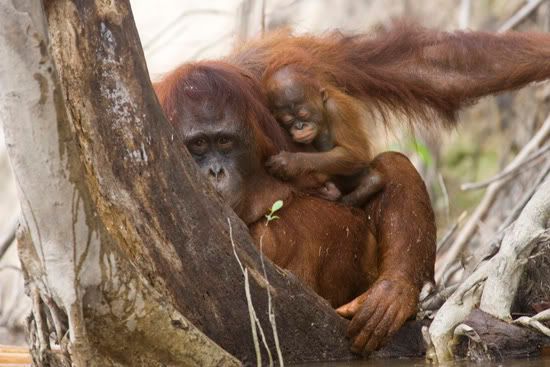
For experts the behaviour of these orangutans – who like all apes have
a natural fear of water because of predators such as crocodiles -
could prove to be a significant step forward in their evolution.
“This is a rarity – to see orangutans coming down for a swim is
unheard of in the wild,” says Simon Husson – project advisor and
scientific consultant for Borneo Orangutan Survival (BOS) Foundation.
“However, we know that orangutans are intelligent and innovative."
Source
river have left wildlife experts stunned.
Playing on the Rungan River, near to Palas Island on Borneo, these
orangutans can be seen swimming and submerging themselves in the muddy
waters.





For experts the behaviour of these orangutans – who like all apes have
a natural fear of water because of predators such as crocodiles -
could prove to be a significant step forward in their evolution.
“This is a rarity – to see orangutans coming down for a swim is
unheard of in the wild,” says Simon Husson – project advisor and
scientific consultant for Borneo Orangutan Survival (BOS) Foundation.
“However, we know that orangutans are intelligent and innovative."
Source
Labels:
animals,
nature,
orangutans
Is Premium Dog Food Worth the Cost?

By Lexiann Grant
When looking at what it costs to feed your dog, it's important to understand that not all dog foods are created equal. Quality kibble can make your dog healthier and probably doesn't cost as much as some might think.
In the 1970s when I adopted my first puppy, I knew very little about dogs and dog food. I just purchased an inexpensive brand from the grocery store while shopping for my own food. I thought buying special flavors in appetizing packages equated being good to my dog.
Wrong. My first dog – a finicky eater – was excessively thin in body and coat, not good for an Afghan Hound. She also had digestive problems.
With my second dog I decided to try a different kibble. The one I chose was a bit better and cost a little more, but I was still clueless about what constituted a healthy product. This dog had ear infections, dry itchy skin and allergies her entire life. She was the only Afghan I knew who couldn’t run without tiring easily.
I had heard from some of my friends how expensive the premium dog foods were compared to the grocery store dog foods I was buying and was reluctant to spend what seemed like more money for the same number of pounds of dog food.
So I kept feeding the same kibble to the next four dogs my husband and I adopted. Every few weeks, one of the dogs was at the veterinarian’s for flaky skin, minor skin cysts, dirty ears, heavy shedding, mild respiratory infections or low energy. All the dogs had thin, dull coats and were generally lackluster. Despite my personal inclination to healthy, balanced eating, I just assumed the dogs’ food was nutritionally sound enough, and never really made the connection. Even though these conditions can have many different causes, I eventually decided that trying better foods was the easiest solution.
Before making the switch to better food, we were told repeatedly at dog shows that our Elkhound was “out of coat.” We kept waiting for him to grow the full adult coat as he aged. Extra portions, vitamins, oils, herbs, and unusual supplements added to his inexpensive food did not make that happen.
Finally another handler asked what we fed, and suggested trying a premium food. I started researching ingredients, pet food standards and labeling practices. I realized that if you compared a premium dog food pound for pound to things we all buy in the grocery store, it's really not that expensive. Here's an example. At Walgreens a 14 ounce box of Cheerios costs $4.50, so 30 pounds of Cheerios would be about $150! Cheerios is mostly grains, corn starch and sugar. A 30 pound bag of super-premium pet food like CANIDAE costs about $34 where I live so it costs just a little more than a dollar a pound. A typical dog eats less than a pound a day, so feeding a premium food can easily cost less than a dollar a day.
After I figured all this out for myself, I picked CANIDAE as the dog food to try. It was affordable, and it also finally improved my Elkhound's fur! At the shows, we received compliments on how great our dog’s coat looked, and were asked what food we fed. My husband’s reply: “CANIDAE. It’ll grow hair on a bowling ball.”
Long before I became a CANIDAE Responsible Pet Ownership blogger, I fed CANIDAE because diet is everything; it is the foundation for good health.
In this brutal economy, it’s necessary to save money. But cutting corners on pet food won’t net any savings. That’s because less expensive products use lower quality ingredients. Pennies saved on kibble can turn into big bucks spent at the vet’s.
“Premium” in dog food means a higher standard in nutrition and quality of ingredients. Pound for pound, the price of premium food is higher. But each serving contains more nutrients that are more nutritionally available than in a cheaper food, making premium kibble the better buy. With more nutrients in every bite, dogs do not need to eat as much premium food as they would a brand containing fillers and by-products.
Want help including premium kibble in your budget? Check out the handy new calculator that figures the daily cost of feeding CANIDAE All Natural Pet Foods based on your dog’s weight. Go to www.canidae.com/cost-to-feed-canidae/. From the pull-down menus, answer the four questions about which formula and size bag you feed (or would like to try), your dog’s weight and the amount your pet supply store charges for the selected product. Then click the “calculate” button to see how affordable premium dog food really is.
Although no single dog food is right for every dog, premium foods like CANIDAE make a positive difference. Remember, you get what you pay for: high quality food can equal better health.
The internet likes rawhide dog bones
At whatdoestheinternetthink?net, I asked what the Internet thinks about rawhide dog bones.

Great news - that's what we sell at i-pets.com!
You can ask the internet a question, too.
(via The J-Walk Blog)

Great news - that's what we sell at i-pets.com!
You can ask the internet a question, too.
(via The J-Walk Blog)
Labels:
i-pets.com,
rawhide bones
Fat cat ad
From this:
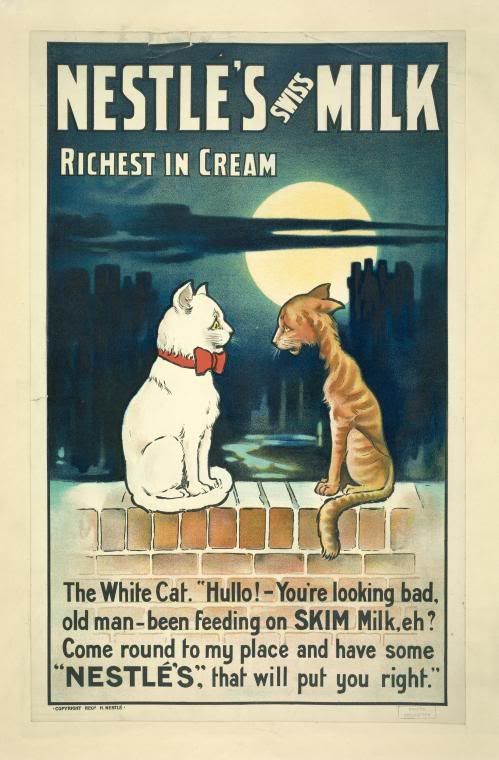
To this:
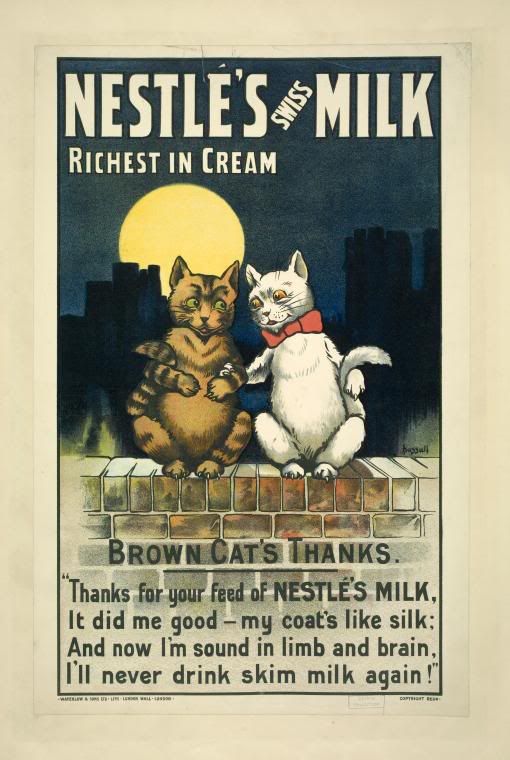
From the New York Public Library (NYPL) Digital Gallery
Image ID: 1261066 & 1259072
Nestle's Swiss Milk posters by John Hassall (1893-1924)

To this:

From the New York Public Library (NYPL) Digital Gallery
Image ID: 1261066 & 1259072
Nestle's Swiss Milk posters by John Hassall (1893-1924)
Labels:
advertising,
animals,
art,
cats
Sick perverts
 Muskogee County, OK, prosecutors on Tuesday charged a man and woman with fatally shooting and skinning a 7-week-old puppy they intended to make into a belt.
Muskogee County, OK, prosecutors on Tuesday charged a man and woman with fatally shooting and skinning a 7-week-old puppy they intended to make into a belt.A judge ordered mental competency testing for Austin Michael Mullins, 26, and Krystal Lynn Lewis, 23.
Muskogee County sheriff’s Deputy George Roberson said Mullins shot the puppy 10 times with a .22-caliber pistol at a park near town, and Lewis then skinned the puppy at her apartment. The pair nailed the hide to a board displayed at the apartment and told investigators they planned to have it made into a belt.
Source
Labels:
bizarre news,
crime,
dogs
2,500-year-old bird's nest found
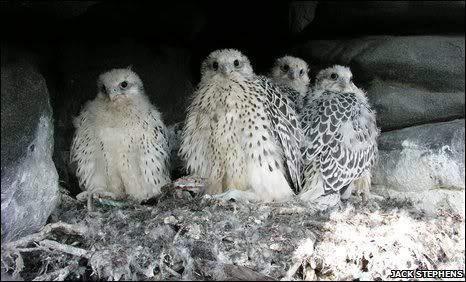 A 2,500-year-old bird's nest has been discovered on a cliff in Greenland.
A 2,500-year-old bird's nest has been discovered on a cliff in Greenland.The nesting site is still continually used by gyrfalcons, the world's largest species of falcon, and is the oldest raptor nest ever recorded.
Three other nests, each over 1,000 years old, have also been found, one of which contains feathers from a bird that lived more than 600 years ago.
Like many falcons, gyrfalcons do not build nests out of sticks and twigs, but typically lay eggs in bowl-shaped depressions they scrape into existing ledges or old nests made by other birds such as ravens.
Source
Doing a Good Job
 Six days a week we receive an unpleasant visitor. Armed with potentially desirable offerings, this visitor marches up to our front door, reaches into his bag, and then carelessly hands off what is rightfully mine.
Six days a week we receive an unpleasant visitor. Armed with potentially desirable offerings, this visitor marches up to our front door, reaches into his bag, and then carelessly hands off what is rightfully mine.We call him Grouchy Mailman.
Grouchy Mailman apparently doesn't like our mailbox. We live in a 100 year old house. There is a wonderful small door beside the front door, a tiny door with insulated sides which originally served as a milk box. (See the picture above. This is Hudson, our yellow lab, trying to fit out the milk box door!!) For more than 20 years, our newspaper and mail have been slid into the milk box, which I can open from another tiny door inside the enclosed front porch, allowing me to collect the mail without having to step outside in my pajamas.
But Grouchy Mailman decided that it was too much effort to be sure the mail fit into this box, so he began simply dropping my mail to the ground beside the steps. More than once I had to chase an envelope caught in the breeze. Since I conduct business through the mail, with vital communications from editors and--more importantly--pay checks, I was not pleased to think of what might be blowing away down the street.
I am not big on confrontation, but finally decided to nicely ask Grouchy Mailman to be sure my mail got into the box. After all, if it was big enough for a few bottles of milk, surely it was big enough for my envelopes. Not to mention, since I work from home, if something was too big to fit in my milk box mail box, he could have rang the bell and handed me the envelope in a jiffy. But my talk with G.M. did not go well. He flat out refused to turn the envelopes sideways, all that would have taken to make sure taller envelopes fit without falling out.
I suppose I could have called the post office and spoken to his supervisor. Maybe even should have. But I imagined this would have made G.M. even grouchier, and my mail might have suffered a far worse fate. So I ignored the little voice that said I was right, bought a new mailbox, and mounted it above our quaint old milk door. Now, at least, the mail is not on the ground.
Then I was talking with my mother-in-law, who lives across town, and she was telling me about her postal worker. He brings her stamps and lets her give him cash for them, asks her if she needs anything. He goes out of his way to smile and say hello and good morning. And recently, after having her mail held while she was away for a few weeks, he brought it to her personally when she returned, without having to go through any paperwork, so she wouldn't have to stand in line at the post office. He checks to make sure the seniors in the neighborhood are okay. I imagine G.M. would rush by, figuring it was none of his concern.
I know, our jobs aren't always a barrel of fun every day. Maybe Grouchy Mailman's back hurts. Maybe he got chased by a dog. But he's not helping himself by having a bad attitude. We can dread each day and grumble and complain. I do that sometimes. But we can also take the very same situation and put our heart into it and ask God to use us in some way that will honor him. I always ask God to guide my words as I write.
I like to think of these two mailmen; mine and my mother-in-laws. One grumbling and giving poor service, and the other smiling and seeking ways to go above and beyond to help others. Same job. Same town. Similar circumstances. Different attitude.
God, please don't let me be a grouchy mailman today.
What I Learned From my Dog: Kelly must be a good judge of character. She doesn't like the mailman either.
Dogs Never Stop Chewing

By Ruthie Bently
I recently bought Skye a sterilized natural bone, and she was in her yard chewing on it when a friend came over. He asked me how old Skye was and I replied that she would be four this summer. That surprised him, because she was still chewing. After all she had all her permanent teeth, so he wanted to know why she was still chewing. As he had never owned a dog and wanted to understand, I explained that it doesn’t matter how old a dog is; they never stop chewing.
Dogs never stop chewing. Sounds funny doesn’t it? But the truth is that while dogs stop teething, they never stop chewing. This should come as no surprise to anyone who owns any dog that is used for hunting or retrieving, as they are very oral by nature. Most Retriever and Terrier owners I know have a good supply of nylon bones or chewies to keep their four legged kids busy.
Dogs’ teeth are not visible when they are born, and 28 puppy teeth begin coming in between three to six weeks of age. This is when a puppy begins to chew. They start losing their puppy teeth by the age of thirteen weeks. Dogs’ adult teeth (they have 42) begin coming in between the age of two and seven months. So you could see some heavy duty chewing between the ages of three weeks to seven months. The chewing will slow down as they get older, but it never stops completely.
Dogs can’t pick up things with their paws the way we do with our hands, so they use their mouths to taste and test the things they pick up. They are curious, so it doesn’t matter if it is the TV remote, a cell phone, glasses or a shoe on the floor; they have to check it out. Chewing helps remove plaque from your dog’s teeth, and is a good addition to brushing your dog’s teeth regularly. So if you have a good supply of nylon bones, sterilized natural bones and other chewies you can keep your dog (and yourself) happy, as they won’t be looking for things that they shouldn’t be chewing and that could be dangerous for them.
I have observed that dogs will work out frustrations when they are chewing. When Skye can’t find a favorite chew toy, she will go after a “non-approved” dog toy. That usually means a plastic drink bottle or cottage cheese container; though it has included wood logs and shoes. She takes the plastic out of the recycle bin and the wood out of the wood box because she can reach them. I would rather that she picked a dog toy, but she just wants something in her mouth and is too lazy to go looking for a real toy. She has a toy box outside and one inside as well, so it isn’t like she can’t find anything to suit her. Skye knows that it’s not a dog approved item, so she could be doing it for the attention factor as well. All I know is that Skye needs to chew.
One way to help your own canine chewer is to have duplicate chewing toys around the house in different rooms, as well as some toys that are designated outside chewing toys. An outside chewing toy would be one that you would not want leaving grease on your leather sofa, or that may get sticky during chewing and leave gooey bits around the house that are difficult to clean up.
Remember, our dogs are like children in that they should not be left alone with any toy no matter how safe you think they might be. You should always supervise your dog with any toy that you choose to allow them to have. By carefully supervising the toys your dog chews, you shouldn’t have the same issues that we have had with Skye and hopefully you can learn from our mistakes. As they say: “forewarned is forearmed.”
Read more articles by Ruthie Bently
Labels:
canidae,
chewing,
dog,
ruthie bently,
teething
Extreme Mammals
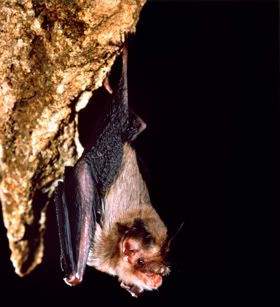 Found only in Thailand and Myanmar, the bumblebee bat is no bigger than a bumblebee and weighs only about as much as a dime.
Found only in Thailand and Myanmar, the bumblebee bat is no bigger than a bumblebee and weighs only about as much as a dime.This is just one of the unusual animals featured at Extreme Mammals, where you can meet some of your more bizarre relatives.
How about you. Are you extreme?
Well, yes and no. On the normal side, we are warm-blooded, have hair, nurse our young and have three middle ear bones. Like ancestral mammals, we have sharp front teeth and grinding back teeth.
On the extreme side, our brains are remarkably big for our body size. Our thumbs can close against our fingers with both strength and delicacy. Our tail is just a remnant of a few hidden bones, and our body hair is very sparse.
How about walking around on two legs? What might seem to humans like the most normal thing in the world is actually one of our most unusual features. The only other mammals that travel primarily on two legs all hop like kangaroos. Walking human-style is rarer in mammals than laying eggs!
Photo: Dr. Merlin D. Tuttle/Bat Conservation International/Photo Researchers
Waste some time
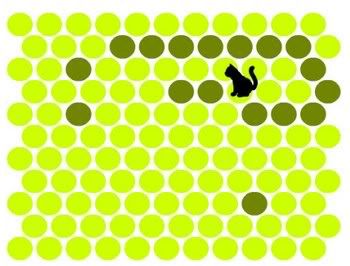 The object of this game is to trap the cat – keep him from jumping off the game board. You click on a circle and the cat jumps one place. Keep it up until you trap the cat and he can’t escape.
The object of this game is to trap the cat – keep him from jumping off the game board. You click on a circle and the cat jumps one place. Keep it up until you trap the cat and he can’t escape.(via Bits and Pieces)
Attention Cat Butt Lovers!
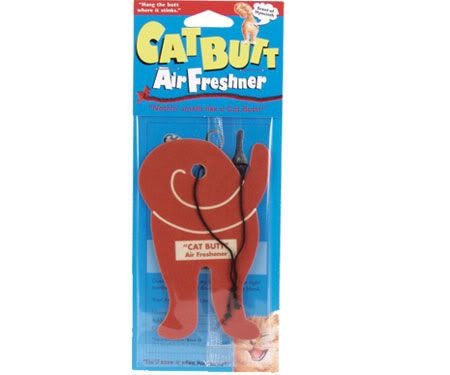 Nothin' can beat the smell of a cat's butt... you'll know it when you smell it!
Nothin' can beat the smell of a cat's butt... you'll know it when you smell it!The Cat Butt Air Freshner has a fresh Hyacinth scent - just like your own cat's, but this is more portable.
Available at Perpetual Kid.
Oooh look, they have Cat Butt Stickers, too!
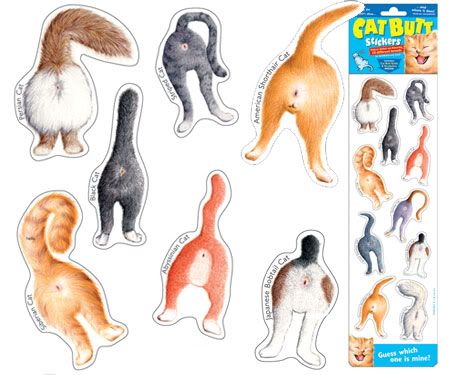
Labels:
animals,
bizarre,
merchandise
Want to sleep on your dead pet?
 What could be more comforting than the memories of your late pet laid to rest beneath your sleeping head? If a cherished pet's death leaves you sleepless and missing that warm, furry embrace, then Patricia Moore of Naples, Fla., may have the answer: pillows stuffed with your pet's ashes.
What could be more comforting than the memories of your late pet laid to rest beneath your sleeping head? If a cherished pet's death leaves you sleepless and missing that warm, furry embrace, then Patricia Moore of Naples, Fla., may have the answer: pillows stuffed with your pet's ashes.Moore started Soft-Hearted Products after she lost her own dog, Samantha. Samantha was cremated and her ashes were returned to her owner in an urn that felt cold and impersonal.
"She was always with me," Moore said. "On my lap, on my bed, next to me. I missed that so much."
Source
Labels:
bizarre,
merchandise,
pets
How to Keep an Indoor Cat Happy

By Julia Williams
Until recently, I didn’t believe an indoor cat could be happy. I thought that “depriving” a cat of the outdoors would surely make them depressed, lethargic and overweight. I saw how much my own country kitties enjoyed climbing trees, fences and trellises, lounging in the garden, and hunting the ever-prolific gophers on our five acre field.
Then we moved back to the small town of my childhood, and my cats became primarily indoor cats. They were scared at first, and hid in the bedroom closet for a week. I wasn’t going to let them go out for at least a month anyway. When they finally did come out of the closet, my California born-and-raised cats took one sniff of the cool Montana air and must’ve decided then and there that being indoors suited them just fine. And when the snow came, it pretty much sealed the deal.
I worried that they’d hate being inside and cease to be the joyful kitties I knew and loved, but soon realized that my concerns were unwarranted. In fact, to my surprise they now show little interest in going outside, even when offered the opportunity. I did make some adjustments to their indoor environment however, to make it as kitty-hospitable as possible. The key to keeping an indoor cat happy, it seems, is providing them with plenty of stimulation and attention, along with an enriched environment.
So what does that entail, exactly? I keep my indoor kitties stimulated by having lots of different cat toys for them to play with. I bring home a huge bag of Christmas clearance cat toys from my local pet store every January, and rarely spend more than $10. Some of those toys have a holiday theme of course, but the cats don’t know the difference or care, and neither do I.
The important thing to remember about cat toys is that every kitty is different; for example, mine go crazy for furry mice but get bored with balls in a nanosecond. If I buy assortments that have balls in them I give those to my sister, whose cats love to bat balls. Soon enough you’ll discover which types of toys your cat likes best, and you can get more of those.
Another other thing to keep in mind is that you need to rotate your cat toys frequently. Once a week I swap out all the toys with others that I keep in the “cat toy drawer.” In a feline’s world, this is like getting brand new toys to play with every week.
I also buy them toys that require human participation – like mice-on-a-stick, lasers, and cat “fishing” poles – which accomplishes both the stimulation and attention aspect. I also try to give each of my three cats my undivided attention every day, no matter how busy I am. I brought these cats into my family because I wanted to give them love and a good home, and I owe it to them to pay attention to them. Now that they’re primarily indoor cats, they are a bit needier and they crave more attention than they did before, so I adjusted to accommodate them.
Besides playing with them, you can also give your cats attention by having petting sessions, lap time, and grooming time. As with the toys, you need to discover what your cat likes the most, and do more of that. Annabelle loves to be brushed and combed (that’s an understatement), so this is what I do for her time. Mickey loves to sit on my lap, so I let him, even if it means I have to sit two feet away from my keyboard. Rocky prefers plain vanilla petting, so he gets that.
The third aspect to keeping an indoor kitty content is an enriched environment. In other words, you need to provide things besides toys that make them happy. My cats like to lie on the back of the sofa and watch the birds, so I placed a comfy sheepskin kitty mat there to contain the cat hair. You can also buy window perches that accomplish the same thing. You might want to get them a cozy cat bed or cat “donut” to sleep in, too. If your kitty likes to nibble on grass, it’s easy to grow special cat greens for them.
Cat towers and cat condos are a great way to provide your cat with a place to nap, scratch, climb, play and perch, all in one day! It’s also a good idea to provide your indoor cat with various scratching surfaces— I have several styles of corrugated cardboard scratchers, as well as a carpeted scratching post. I’ve learned that when it comes to cats, you really can’t have too many scratching posts!
My cats are probably not as happy indoors as they were outdoors, but they are happy enough. Given that indoor cats live longer and are typically healthier, that is good enough for me.
Read more articles by Julia Williams
Labels:
canidae,
cat condo,
Cat toys,
indoor cat,
Julia Williams,
pet store,
scratching post
Body Language of Dogs

By Linda Cole
As pack leader of multiple dogs, it's our responsibility to keep our animals stable and free from aggression by other members of our pack. We can hear a bark, growl or whimper which can signal a change in a dog's temperament. Body language will also give us a clue something is wrong that has upset or frightened a member of our pack. Just as we display happiness, anger, fear and even aggression in our face and body language, a dog will also have visible signs showing how they are feeling.
Dogs communicate and interact with each other through body language. They use this knowledge with us, as well. My pack understands when it's time to go outside because of certain movements and actions I take. That's the signal they are watching for and they respond with no spoken words from me.
People, especially children, can be injured when they don't understand what the dog is trying to say to them. Children can and should be taught how to determine a dog's state of mind by observing its body language. Watch your dogs closely when any children, including your own, are playing with or simply petting them. Not all dogs like to be petted, especially around the head and ears. Some feel intimidated with a hug, being laid on or wrestled with. Bites can be stopped before they happen when you and the child recognize and understand when the dog is saying, “I've had enough and it's time to back off.”
A dog who rolls over on its back with the tail tucked between his legs is in a submissive position. Lip-licking helps reduce stress and show others they are being compliant. Crouching down with their butt in the air says “I want to play.” Eye contact, especially if it's intense or an actual stare, can indicate this dog is ready to rumble. A dominate dog is always ready to challenge authority in the pack, but they will respect and honor commands as long as your body language indicates you are leader of the pack.
A confident dog holds his tail erect with a gentle slow wag. He stands or sits tall and erect, head held high. You can see his ears are pricked up as he listens and the eyes are relaxed looking with no “whites” showing. The body language of this dog says “Everything is cool and I feel good.”
An aggressive dog stiffens in his body and legs. His tail will be lower and held out straight. He may or may not signal his displeasure with a growl. Ears are flattened against his head and the head will be lowered. His hackles, the hair on his back, rump and around the shoulders, will be raised. Angry eyes stare intently and become narrowed. The lips may be curled into a snarl.
The fearful animal may be hard to predict. Fear in any species can make that individual unpredictable and potentially dangerous. A fearful dog has its tail tucked between their legs or it may hang straight down with a wag that is fast and uncertain. The back is arched and his head and rear are lower. The legs are slightly bent. He may turn his head away and look out of the corner of his eyes showing the whites of the eye while trying to avoid looking at what's causing the concern or fear.
A strong pack leader understands members of the pack need to be allowed to settle small differences on their own. However, when a dog's body language indicates a fight could be brewing, it's time to step in and remove the offending dog for a brief cooling off period. It’s a refocusing of the mind, if you will.
Dogs are only concerned with what's going on right now. An aggressive or fearful dog can return to a confident and feeling good pet in a matter of seconds. Dogs will respect a pack leader who stays cool under pressure and responds to the needs and safety of the group by being assertive, consistent and fair to all members of the pack. Understanding body language of dogs allows you to step in and stop problems before they arise. Maintaining a healthy, happy pack is as simple as watching what your dog is trying to tell you.
Read more articles by Linda Cole
Subscribe to:
Posts (Atom)
